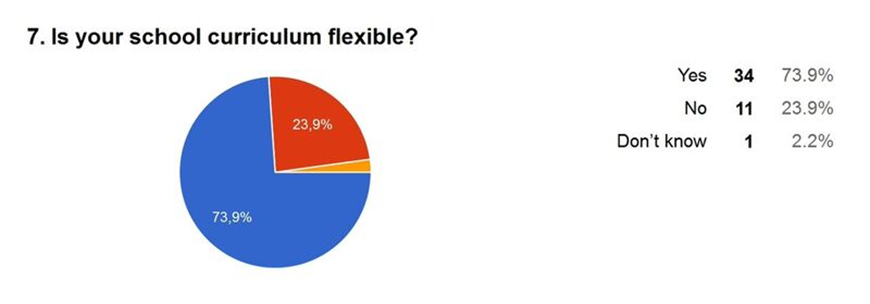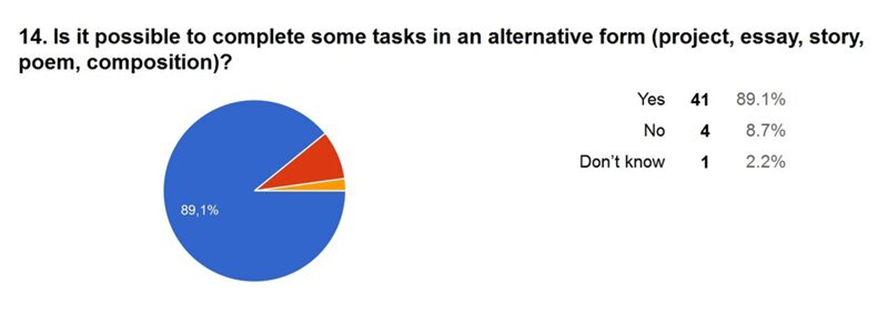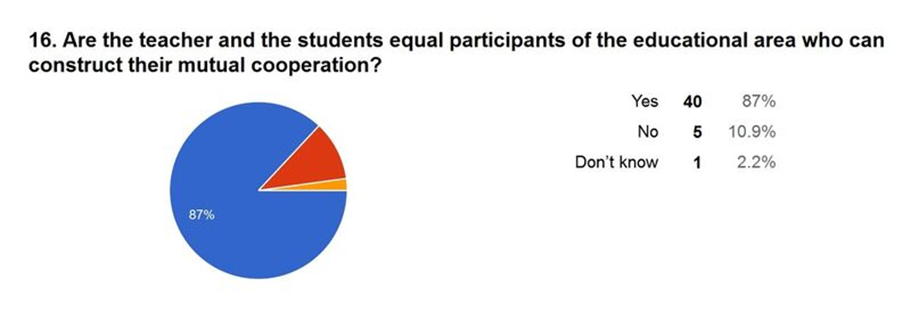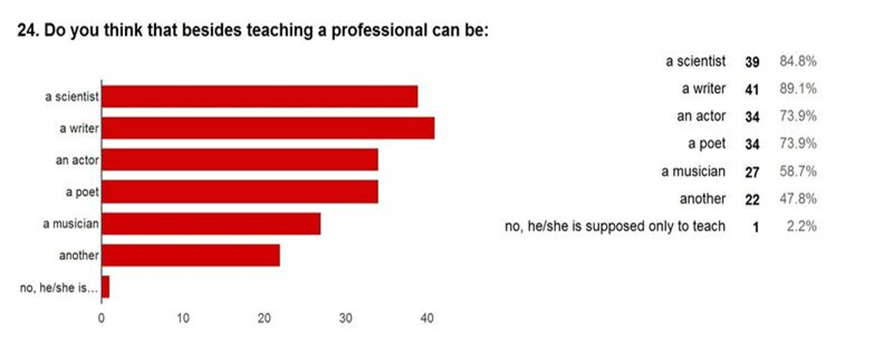Abstract
To analyze the effectiveness of modern alternative (charter, voucher, magnet) schools that emerged in the United States as a postmodern didactical project, the paper presents a conceptual, comprehensive analysis of the scientific research array, of education quality study results (the results of a national testing), investigating both the experience of their work on the basis of annual reports and of the school leaders and teachers’ interviewing results. The conceptual analysis aimed at solving the problem of studying the complex of documents (annual reports of alternative schools, scientific reports, the results of national tests, studies of American scientists for the period from 2003 to 2016) to study the effectiveness of alternative schools in the United States and their impact on public schools. The survey was attended by representatives of 32 schools from 17 States. The highest number of answers was given by charter schools (73.9%), and the lowest − from vouchers (10.9 %). This result is predictable, since charter schools have gained a predominant distribution in the United States, thanks to the support of former US President Barack Obama and current President Donald Trump. The general trends of postmodernism characteristics’ implementation (rhizomatic nature, plurality, cartography, heterogeneity, contextuality, etc.) can be observed in all the alternative schools in the United States, indicating the influence of postmodernism ideas on these schools.
Keywords: Alternative schoolpostmodernism
Introduction
Under the influence of postmodernism ideas which became the "time-trend", the education system has undergone a number of changes: the classical educational model has been deconstructed, the principle of multilevel organization of the educational process has been introduced, the personality-oriented approach has been used, the binarism in the learning process has been rejected (Ivanova, 2015).
Problem Statement
The above mentioned changes have to this or that extend influenced the organization of educational activities in secondary schools of the United States. However, the most significant impact of these ideas is the emergence of new — alternative — types of schools, which demonstrate qualitatively new principles of education.
Research Questions
Alternative schools are defined as optional schools of 3 types: voucher, charter and magnetic. Voucher schools are private schools that implement an alternative educational program and provide virtually free tuition thanks to school vouchers (or charters), which allow parents to choose a school according to their priority values, and where students can choose to study subjects, important for them. Magnet schools (or "schools to attract students") are public educational institutions that have unique subjects in the curriculum or that are focused on one or another educational emphasis (visual, applied or performing arts; exact sciences; socially – oriented subjects; general scientific subjects; traditionally-basic education). Charter schools are usually focused on specific cultures and have an extensive variable academic program, state-of-the-art digital technologies, diverse teaching staff, and a flexible timetable (Young, 2000; Raywid, 1994, Turner & Westervelt, 2016). These are free schools that receive public funding and are run by private individuals.
Purpose of the Study
Is to identify the effectiveness of modern alternative schools that emerged in the United States as a postmodern didactical project.
Research Methods
The conceptual analysis aimed at solving the problem of studying the complex of documents (annual reports of alternative schools, scientific reports, the results of national tests, studies of American scientists for the period from 2003 to 2016) to study the effectiveness of alternative schools in the United States and their impact on public schools; development of tools and questionnaires for managers and employees of alternative schools in the United States, which in practice allowed to show the effectiveness of postmodern ideas’ influence on alternative schools in the United States.
Findings
The effectiveness of voucher schools is not sufficiently confirmed. A number of researchers have found an improvement in the results of children in traditional schools due to their competition with voucher schools, but there are studies that deny any improvements of this kind entirely (Amos, 2013; Figlio & Hart, 2010; Wisconsin Department of Public Instruction, 2014).
The data obtained in the course of the study concerning the assessment of magnet schools’ role in improving the students’ performance gave mixed results: some show higher levels of performance in magnet schools students, while others, on the contrary, demonstrate their progress being equal to non-magnetic schools students. Most studies confirm that more black and Hispanic students, as well as low-income students attend magnetic schools rather than public schools. However, the studies’ results of the magnetic schools success in promoting racial integration are controversial (Cobb, Bifulco & Bell ,2009)
However, it remains unclear whether charter schools can be competitive to traditional schools, forcing changes in the established direction of education. Taken together, the empirical data allow making an unambiguous conclusion about the positive impact charter schools have on other schools. Charter schools are so different that each of them should be assessed by its own efficiency criteria (Booker, Sass, Gill & Zimmer, 2011; Bifulco & Ladd, 2006; Cobb & Glass,1999; Davis & Raymond, 2015; Indiana Department of Education, 2014; Tuttle, Gill & Gleason, 2013; Zimmer & Engberg, 2013).
If these studies were intended to demonstrate the effectiveness of alternative schools, the results of the questionnaire survey in these schools confirmed our hypothesis that they are a modern postmodern didactic project. The survey was attended by representatives of 32 schools from 17 States. The highest number of responses came from the States of California and Wisconsin (16 per cent each of the total percentage of participants) and from teachers (32 responses, representing 69.6 per cent of the total number of respondents).
Thirteen answers were received from school administration (28.3%) and one response came from an assistant (to 2.2%). The highest number of answers was given by charter schools (73.9%), and the lowest − from vouchers (10.9 %). This result is predictable, since charter schools have gained a predominant distribution in the United States, thanks to the support of former US President Barack Obama and current President Donald Trump, who emphasized the development and financing of such schools in his election campaign.
Particular importance was attached to the fact that the survey was conducted anonymously, respondents had to indicate only the name of the school, the type of their alternative school and the state in the United States. It is important to note that, according to the results of the questionnaire survey, a scientific cooperation was established with many schools. The questionnaire contained thirty statements made in the form of questions, of which twenty-nine questions were presented in a closed form and assumed the choice of one of the proposed answers. One last question was formulated in an open form, which allowed the respondent to express their own point of view on the advantages and disadvantages of alternative schools if compared to traditional ones.
In drawing up the questions of the first block of the questionnaire we were guided by the purpose to consider the structure of the educational environment and the principles of its organization from the standpoint of postmodern philosophy of education. It was found that the educational environment has a coherent, discrete structure reflecting the principle of rhizomatic training. Respondents' answers to the first block of the questionnaire confirm the implementation of individual, subjective learning process in alternative schools of the United States, in which each part and conditions of its existence (teacher, student, social status, level of teaching) play an important role in the construction of the educational environment.
Since each element of the educational environment is important in the postmodern educational system, as well as the connections in which it exists, we were interested in other elements of the educational environment: curricula, schedules, forms of classes. They have become the criteria when composing the questions of the second block of the questionnaire. First of all, we decided to consider such a part of the decentralized educational environment as the flexibility of the curriculum. Therefore, the following question was related to the respondents' views on whether the curriculum in their alternative schools was flexible. The results of the survey confirm that the absolute majority of respondents (73.9%) believe that their schools use a flexible curriculum (Fig.1). This reflects the postmodern principle of the constructability of the learning process in alternative schools in the United States (Slattery, 2013).
Moreover, the flexible curriculum reflects the opportunity to involve students in creating an educational process, to make learning individualized, to meet the needs of time and society in a flexible mode. It is important to note that the results of the answer to the question showed that the curriculum in most alternative schools is made individually for the student, which corresponds to the principle of cartography.

The next question was about the percentage of subjects to choose from. In our opinion, the increase in the number of variable subjects in secondary and high school indicates, first of all, the rejection of the structuralism, the hierarchy of learning. Postmodern education is aimed at poly-context, that is, the transformation of the educational environment into a decentralized management system that allows teachers to work freely and efficiently, as well as to easily adapt to any changes in the environment.
Since the most important subject in the educational environment is a student with his / her needs, it was important for us to consider what needs are taken into account in scheduling. Therefore, one of the questionnaire questions offered to select variants of needs: cognitive, social and communicative. The results of the survey showed that the vast majority of respondents (89.3%) chose cognitive needs, which rightly points to the degree of the student’s inclusion in the educational environment and awareness of their role and the degree of their participation in it.
When answering the next question of the questionnaire one had to indicate how often the content of education was updated in accordance with the requirements of the time. The results were as follows: the majority of respondents (60.9 per cent) noted that the content of education in their schools was changing as often as needed; 19.6 per cent of respondents supported the answer describing annual updating of the education content. The results confirm the need to consider education as a part of a broader sociocultural environment subject to the same changes as the environment itself. Moreover, the educational environment itself is constantly being constructed, there is nothing static in it anymore; it is changeable and poly-variable.
The refusal of binarism in education and the focus of education on the search for gifted children reflect the poly-contextual principle of the learning process, which determines the strategy of creating a purely individualized, personality-oriented approach to studying. Therefore, it was important for us to see how the formalization of the approach to knowledge assessment in the form of testing expresses the students’ real needs and allows you to notice their individuality. We had expected that the question on whether the tests were the only form of students ' knowledge assessment got 93.5% of negative answers. It indicates a wide variety of assessment tools in the United States and refutes the myth that only testing verifies their students’ knowledge.
When analyzing the internal components of the educational environment, it is impossible to ignore the forms of education. In classical education, these were a plan and a summary of the lesson, so the next question was related to their role in the educational process planning. In response to this question, the majority of respondents (60.9 %) disagreed that they relied only on the plan and summary of the lesson in their professional activities. The analysis of the answers to this question, as well as to other questions of the second block of the questionnaire, confirms the effectiveness of the postmodern education principles and the creation of conditions for their implementation through flexible schedules, curricula and forms of training.
When asked about the possibility of changing the content of lessons on a particular topic depending on the educational situation, 87% of respondents answered positively, and only 13% − negatively. This result (Fig.2) proves that the idea of postmodernism on constructability, eventfulness of the learning process, its dependence on social conditions takes place in alternative schools. The dependence of the lessons’ content, themes and applied forms of learning on the training situation indicates the implemented principle of connectivity and the discrete nature of the educational environment, its subordination to the conditions of all its components’ existence.

Multiplicity and poly-variability of training are aimed at expanding the forms of teaching in order to identify the creative cognitive approach to the students’ needs. To confirm its implementation in alternative schools in the United States, we compiled a questionnaire about the possibility of performing tasks in an unconventional form (project, essay, story, poem). Results of answers to this question (Fig.3) showed that 89,1% of respondents reported on having this possibility in their schools, which confirms that not only the educational environment has a decentered structure, but also forms of learning are multiplying, each of which focuses on a more specific task — that of identifying each student’s needs.

Analyzing the answers for the following question about the methods used in the work, we can conclude that interactive (91.3% of respondents chose this answer) and active (58.7% of respondents) methods prevail at alternative schools in the United States, which indicates the connectivity and discreteness of the educational environment. Those cannot exist without a constant feedback between the teacher and the student.
As a result of the binarism rejection is a change in the teacher’s role in the educational process, the following question was compiled. The vast majority of respondents (87 %) believe that teachers and pupils are equal components of the single learning process in their schools. These results (Fig.4) demonstrate the change in approach to learning: it ceases to be centered, strictly defined. The principle of plurality of learning, its heterogeneity, discreteness, which is aimed at a two-way action and the active influence not only the teacher has over the student, but also the student has over the teacher.

It is noteworthy that with the vast majority of positive answers that the teacher and the student in the school are equal participants of the common educational process, who jointly structure the interaction space, the majority of respondents (95.7%), answering the following question, agreed that the main factor determining this space was the teacher. This result shows that, despite the tendency to abandon binarism in education, there should still be a leading, supporting element in the system, which sets the coordinates of the educational environment existence, in other words, performs the function of a rhizome in the absence of a strictly defined "center".
The next important issue to be studied was the presence of a student-centered approach at the school. The majority of respondents (60.9%) noted that their alternative schools had a personality-oriented approach to studying. This confirms the postulate of postmodernism that any system, including the educational environment, is effective only when it is designed freely and without boundaries by those entities that can not only learn it, but also realize themselves in it.
The third block of the questionnaire is devoted to the teacher’s professionalism and his role in alternative schools. The obtained results refute the claim that the postmodern era will affect teachers and they will become bilingual, thinking about international students, immigrants, etc. At the same time, these results testify to the deep awareness of teachers and their interest in the professional sphere.
Important for us were the answers to the question, devoted to how to organize a school’s work. The results of the survey (Fig. 5) showed that 32.6 per cent of respondents believed that schools should be built on a certain concept, while the majority (54.3 per cent) held the position that it was appropriate to select what was necessary from several concepts.
The next survey question about whether an alternative school teacher could combine other abilities got the following answers. According to the respondents, alternative schools teachers, in addition to teaching, combine the talents of a scientist (84.8%), a writer (89.1%), an actor (73.9%), a poet (73.9%), a musician (58.7%) and other professions (47.8%). It should be noted that there is a position (2.2%) that the teacher should only teach, be engaged in their direct professional activities only. These results (Fig.5) indicate a tendency to change the role of the teacher today. On the one hand, he/she should adapt to social changes, reflect them in his/her activities, be ready to interact with any participants in the educational process. At the same time, on the other hand, the teacher needs to be a personality possessing some traits that attract the students’ attention.

That is why the teacher must have different competencies that demonstrate his/her adaptability to social changes and the degree of social activity in the educational space, which also reflects the postmodernism emphasis on personality-oriented education. Analyzing the most valuable characteristics for an alternative school teacher (there are no more than three of them discussed), answering the next question of the questionnaire, the respondents gave communication the first place (78.3%), then − a positive attitude to students (60.9%) and creativity (56.5%).
The fourth set of questionnaire questions was designed not so much to analyze the strategies and ideas of the postmodern concept of education but to obtain additional information about alternative schools to identify additional forms of modern non-classical concept of education manifestation. The questions of this block of the questionnaire reveal the peculiarities of additional work and its types (if any), characterize the contingent of students, make it possible to understand whether there are acts of violence, vandalism and hooliganism in the school, whether it is possible to consider training in an alternative school more qualitative than in a traditional one, etc. The questionnaire provided the respondents with an opportunity to write their comments, suggestions and questions. Three responses were received saying there was no middle-and senior level school, a wish to include traditional, private and religious schools into the survey (Bokova, 2017; Bokova, 2018).
Conclusion
Thus, the results of the study showed that the system of alternative education in the United States is in demand at present. On the one hand, its formation is influenced by many postmodern ideas and strategies, on the other − in the school system there are internal structural changes associated with the need for the schools staff, teachers to reconsider their place and role in the new educational system, as well as the need to adapt to these changes. The general trends of postmodernism characteristics’ implementation (rhizomatic nature, plurality, cartography, heterogeneity, contextuality, etc.) can be observed in all the alternative schools in the United States, indicating the influence of postmodernism ideas on these schools.
References
- Amos D. S. (2013, August 24). Ohio voucher program expands to include more students. Cincinnati.com. Retireved from: http://archive.cincinnati.com / article/20130824/NEWS0102/308240027/ Ohio-voucher-program-expands-include-more-students
- Bifulco R., Ladd H. F. (2006). The impact of charter schools on student achievement: Evidence from North Carolina. Journal of Education Finance and Policy. No. 1(1). Р. 50 – 90.
- Bokova, T.N. (2017). Analyses of American school staff survey on modern alternative schools efficiency. Revista Espacios. Vol. 38, № 40. P. 7–6.
- Bokova, T.N. (2018). The influence of postmodern ideas on the formation of alternative schools in the USA. Diss. For Doctoral degree, Volgograd 373 р. [In Rus].
- Booker K., Sass T., Gill B., Zimmer R. (2011). The effects of charter high schools on educational attainment. Journal of Labor Economics. No. 29(2). Р. 377–415.
- Cobb C. D., Glass G. V. (1999). Ethnic segregation in Arizona charter schools. Education Policy Analysis Archive. I. 7, No. 1.
- Cobb C.D., Bifulco R., Bell C. (2009). Evaluation of Connecticut’s Interdistrict Magnet Schools. Storrs, CT: The Center for Education Policy Analysis, University of Connecticut, 2009. Retrieved from: http:// www.education.uconn.edu/research/CEPA/assets/Final Magnet Report.pdf
- Davis D. H., Raymond M. E. (2012). Choices for studying choice: Assessing charter school effectiveness using two quasi-experimental methods. Economics of Education Review. No. 31. Р. 225–236.
- Figlio D., Hart C. (2010). Competitive Effects of Means-Tested School Vouchers. American Economic Journal: Applied Economics, American Economic Association. Vol. 6(1). Р. 68.
- Indiana Department of Education. (2014). Choice Scholarship Program annual report: Participation and payment data 2011−2012, 2012−2013, 2013−2014. Retrieved from: http://www.doe.in.gov/sites/ default/files/ choice/ choice-scholarship-program-annual-report-061614.pdf.
- Ivanova S.V. (2015). Didacticheskiy kontsept v epokhu postmoderna. Tsennosti i smysly. №3 (37), 6–13[In Rus].
- Raywid, M.A. (1994). Alternative schools: The state of the art. Educational Leadership, 26–31.
- Slattery P. (2013). Curriculum Development in the Postmodern Era. Teaching and Learning in an Age of Accountability. N. Y.: Routledge / Taylor and Francis, 2013. Р. 20−21.
- Turner C., Westervelt E. (2016) Donald Trump's Plan For America's Schools, September 25, 2016. Retireved from: //http://www.npr.org/sections/ed/ 2016/09/25/ 494740056/donald-trumps-plan-for-americas-schools.
- Tuttle C. T., Gill B., Gleason P.[etc.]. (2013). KIPP middle schools: Impacts on achievement and other outcomes. Washington, DC: Mathematica Policy Research, February 27, 2013.
- Wisconsin Department of Public Instruction (2014). Racine Parental Choice Program (RPCP): RPCP facts and figures for 2014-2015. (2014). Retrieved from: http://sms.dpi.wi.gov/sites/default/files/imce/sms/RPCP%20Sept% 202 014-15%20Program%20Facts.pd.
- Young, T. (2000). Public alternative education: Options and choice for today’s schools. New York, NY: Teachers College Press.
- Zimmer R., Engberg J. (2013). Can broad inferences be drawn from lottery analyses of school choice programs? An exploration of appropriate sensitivity analyses. Working Paper. Nashville, TN: Vanderbilt University, 2013.
Copyright information

This work is licensed under a Creative Commons Attribution-NonCommercial-NoDerivatives 4.0 International License.
About this article
Publication Date
21 September 2018
Article Doi
eBook ISBN
978-1-80296-045-7
Publisher
Future Academy
Volume
46
Print ISBN (optional)
Edition Number
1st Edition
Pages
1-887
Subjects
Education, educational equipment, educational technology, computer-aided learning (CAL), Study skills, learning skills, ICT
Cite this article as:
Bokova, T. N., Milovanova, L. A., & Zaitseva, O. R. (2018). Analysis Of Contemporary Alternative Schools Functioning In The United States. In S. K. Lo (Ed.), Education Environment for the Information Age, vol 46. European Proceedings of Social and Behavioural Sciences (pp. 91-99). Future Academy. https://doi.org/10.15405/epsbs.2018.09.02.11

